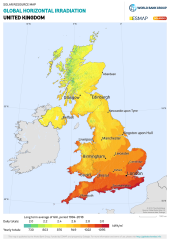Hi, I am looking for a sanity check for a project. I am in the UK.
I work from home with constant low draw electrical devices on ( Lights, computers, monitors, fans, fridges, freezers etc ) and I would like reduce electricity usage. I have about a fairly constant daytime use of about 200w. Everything high draw ( cooker/heating/water etc ) is on natural gas. My understanding is that on a cloudy British day with the system at 10% I would need a 2kw system in order to generate that 200w.
I would like to start very small at 330w and scale out from there.
The first system is to test performance levels at my site to see if it is worth it, and I can extrapolate from there and size out a bigger system. I would like my initial investment not to be wasted, so buying the right initial components would be good. My experience with these type of systems is that a beginner is usually wrong about many things and it is good to gain experience. As I have no battery in my system, any excess is simply given back to the grid, I don't plan on having the inspections and certifying it to local regulations ( despite it being compliant ) and selling electricity back to the grid.
My idea is to use 330w panels ( available locally in the UK for approx £190 ) and individual micro grid tie inverter(s).
There is a 350w Chinese Y&H inverter at around £55 pounds, example: https://www.ebay.co.uk/itm/403087824719 that would match this panel. These inverters seem to be popular, but are they any good ?
I have a suitable unshaded south facing 1 story outbuilding to mount the panels to. The inside could mount the inverters, keeping them out of rain/light etc and making it easy to maintain.
Price per ( potential ) KW would be about £720
The initial system setup seems almost too simple, it this right ? I simply connect the inverter directly to the home system and it floats a higher voltage into the system, which the electrical devices use - I am thinking at 330w I could just wire the ground, neutral, and live to a UK plug and plug it into a power socket. If I scale up I will use proper electrical connectors sized for the amperage.
To scale I simply add more panels, each with a micro inverter in parallel. Or, based on the maths the small initial setup creates, move directly to a 1.5/2/3/4 KW system with a single inverter from Growatt or similar. In that case I either parallel the systems or re-use the initial panel and discard the Y&H inverter.
I work from home with constant low draw electrical devices on ( Lights, computers, monitors, fans, fridges, freezers etc ) and I would like reduce electricity usage. I have about a fairly constant daytime use of about 200w. Everything high draw ( cooker/heating/water etc ) is on natural gas. My understanding is that on a cloudy British day with the system at 10% I would need a 2kw system in order to generate that 200w.
I would like to start very small at 330w and scale out from there.
The first system is to test performance levels at my site to see if it is worth it, and I can extrapolate from there and size out a bigger system. I would like my initial investment not to be wasted, so buying the right initial components would be good. My experience with these type of systems is that a beginner is usually wrong about many things and it is good to gain experience. As I have no battery in my system, any excess is simply given back to the grid, I don't plan on having the inspections and certifying it to local regulations ( despite it being compliant ) and selling electricity back to the grid.
My idea is to use 330w panels ( available locally in the UK for approx £190 ) and individual micro grid tie inverter(s).
There is a 350w Chinese Y&H inverter at around £55 pounds, example: https://www.ebay.co.uk/itm/403087824719 that would match this panel. These inverters seem to be popular, but are they any good ?
I have a suitable unshaded south facing 1 story outbuilding to mount the panels to. The inside could mount the inverters, keeping them out of rain/light etc and making it easy to maintain.
Price per ( potential ) KW would be about £720
The initial system setup seems almost too simple, it this right ? I simply connect the inverter directly to the home system and it floats a higher voltage into the system, which the electrical devices use - I am thinking at 330w I could just wire the ground, neutral, and live to a UK plug and plug it into a power socket. If I scale up I will use proper electrical connectors sized for the amperage.
To scale I simply add more panels, each with a micro inverter in parallel. Or, based on the maths the small initial setup creates, move directly to a 1.5/2/3/4 KW system with a single inverter from Growatt or similar. In that case I either parallel the systems or re-use the initial panel and discard the Y&H inverter.




